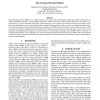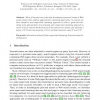100
click to vote
EMNLP
2010
14 years 11 months ago
2010
We propose two hashing-based solutions to the problem of fast and effective personal names spelling correction in People Search applications. The key idea behind our methods is to...
COLING
1996
15 years 2 months ago
1996
Various strategies are proposed to identify and classify three types of proper nouns in Chinese texts. Clues from character, sentence and paragraph levels are employed to resolve ...
NAACL
2001
15 years 2 months ago
2001
We present two methods for learning the structure of personal names from unlabeled data. The first simply uses a few implicit constraints governing this structure to gain a toehol...
LREC
2010
15 years 2 months ago
2010
Electronic patient records (EPRs) are a valuable resource for research but for confidentiality reasons they cannot be used freely. In order to make EPRs available to a wider group...
110
click to vote
SIGMOD
1998
ACM
15 years 5 months ago
1998
ACM
Most databases contain “name constants” like course numbers, personal names, and place names that correspond to entities in the real world. Previous work in integration of het...
IV
2000
IEEE
15 years 5 months ago
2000
IEEE
Annotating photos is such a time-consuming, tedious and error-prone data entry task that it discourages most owners of personal photo libraries. By allowing users to drag labels s...
123
click to vote
JCDL
2004
ACM
15 years 6 months ago
2004
ACM
Today’s web is so huge and diverse that it arguably reflects the real world. For this reason, searching the web is a promising approach to find things in the real world. This ...
110
Voted
ICADL
2007
Springer
15 years 7 months ago
2007
Springer
Most of the previous works that disambiguate personal names in Web search results often employ agglomerative clustering approaches. In contrast, we have adopted a semi-supervised c...
OSDI
2006
ACM
16 years 1 months ago
2006
ACM
The Unmanaged Internet Architecture (UIA) provides zero-configuration connectivity among mobile devices through personal names. Users assign personal names
107
click to vote
ICML
2002
IEEE
16 years 1 months ago
2002
IEEE
We propose a new statistical approach to extracting personal names from a corpus. One of the key points of our approach is that it can both automatically learn the characteristics...


